For many customers, the metaverse is a vaguely future idea that has recently piqued their interest.
On the other hand, retailers cannot afford to be so calm about the metaverse. It is speeding up, and this new world will have arrived by the time the holiday shopping season comes. Retailers must understand that laggards may not perform well in 2022 and recognize the time to prepare for a virtual future.
Successful brands have a lively presence not only in the real world but also online, on mobile devices, and social media. The metaverse is just the next step in that presence’s evolution. By embracing virtual reality, merchants may allow customers to connect with their brand in a one-of-a-kind immersive environment that conveys a company’s narrative and distinguishes it. Richly decadent, interactive 3D worlds entice customers to stay longer than traditional websites or mobile applications ever did.
Consider the influence that interesting virtual places may have on Christmas customers, and it’s simple to understand why online sales, customer engagement, and brand loyalty will undoubtedly rise during the year’s busiest shopping season.
Fashion First
The fashion industry was among the first to stake a claim in the metaverse; luxury brands, in particular, invite customers to explore and play in cutting-edge virtual environments:
- Gucci promoted a virtual handbag on the popular gaming platform Roblox and sold it for $4,100, far exceeding its physical price tag.
- To commemorate the founder’s 200th birthday, Louis Vuitton created a virtual game filled with trivia challenges, prizes, and surprises aimed at attracting young customers.
- In its Atelier of Dreams, Dior Beauty created its own holiday virtual store, emphasizing gift options and limited edition products.
“Marketers, store designers, merchandisers, and others will have to reconsider what a ‘store’ is,” says Maghan McDowell in Vogue Business. “Why on earth would we take our industrial-era version of shopping as a pattern for the future in a world where any experience is possible?” She describes virtual stores as “a third method of shopping that resembles neither stores nor websites,” combining “the best of both the real and virtual worlds.”
Data is important
The metaverse is still in its early stages, but data analysis indicates where it’s headed. Bloomberg predicts that the metaverse industry will reach $800 billion by 2024, dubbing it “the next major technological platform.” Compared to a market of less than $500 billion in 2020, this compound annual growth rate (CAGR) of more than 13%.
Gaming gear, software, services, and in-game ad revenues are the critical income producers in the metaverse, with sales expected to reach $413 billion in 2024, up from $275 billion in 2020. The metaverse market is predicted to roughly triple the present game market. However, online game developers who grab the potential to construct virtual worlds within their games (think Gucci and Louis Vuitton) may gain a more significant portion of future gaming revenues.
Looking ahead ten years, a Credit Suisse analysis from February 2022 forecasts that “even moderate metaverse utilization” may increase the CAGR for internet traffic by 37 percent above the current 30 percent pace, thereby increasing current data usage 20 times.
At the user level, it has been discovered that customers spend more than 14 minutes engrossed in 3D virtual purchasing experiences compared to less than two minutes on static 2D e-commerce sites. This increase in consumer involvement corresponds to a 70% rise in conversion rates, while shops offering a virtual shopping environment such as a metaverse have seen ROIs improve by 450%.
Aside from that, merchants who employ today’s advanced virtual reality technology have access to data analytics based on metaverse user interactions, which may improve product placement. Marketers may not only discover which goods are the most popular, but they can also evaluate traffic and measure user activity, which are critical steps toward enhancing consumer engagement, brand loyalty, and, ultimately, revenue.
Share the brand’s narrative
Virtual experiences, unlike traditional retail venues, have few constraints. They are not hampered by high building expenses, busy showrooms, unsuitable locations, or the inappropriate time of day. Even the most outlandish notions may be wonderfully brought to life in the metaverse and made available to all customers through retailers.
It’s also feasible to administer 3D virtual reality stores using software-as-a-service (SaaS) solutions, which provide retailers with complete management without having technical knowledge. Brands may rapidly and effectively adjust their product lines, shop design, and narratives if they’ve established a strong presence in the metaverse. This enables companies to match virtual storefronts with other channels such as physical stores and websites, which is critical to ensuring that the brand story is consistent across all sales channels, resulting in a flawless omnichannel strategy. Virtual storefronts can also be connected with existing eCommerce platforms, allowing for easier inventory management and direct checkouts.
Customers may leave their regular world behind and engage with companies on an emotional, personal level in the metaverse, which can be both thrilling and comforting.
What is yet to come
It may be some time before the metaverse significantly impacts how we work, play, communicate, and learn. Still, shops should be thinking about various “entry points” right now: “Brands must begin to get their brains around these immersive virtual worlds and prepare their corporate metaverse strategy or risk falling behind.”
Seattle Software Developers can develop a metaverse strategy for your business. Contact us today to discuss your business can approach the Metaverse.





